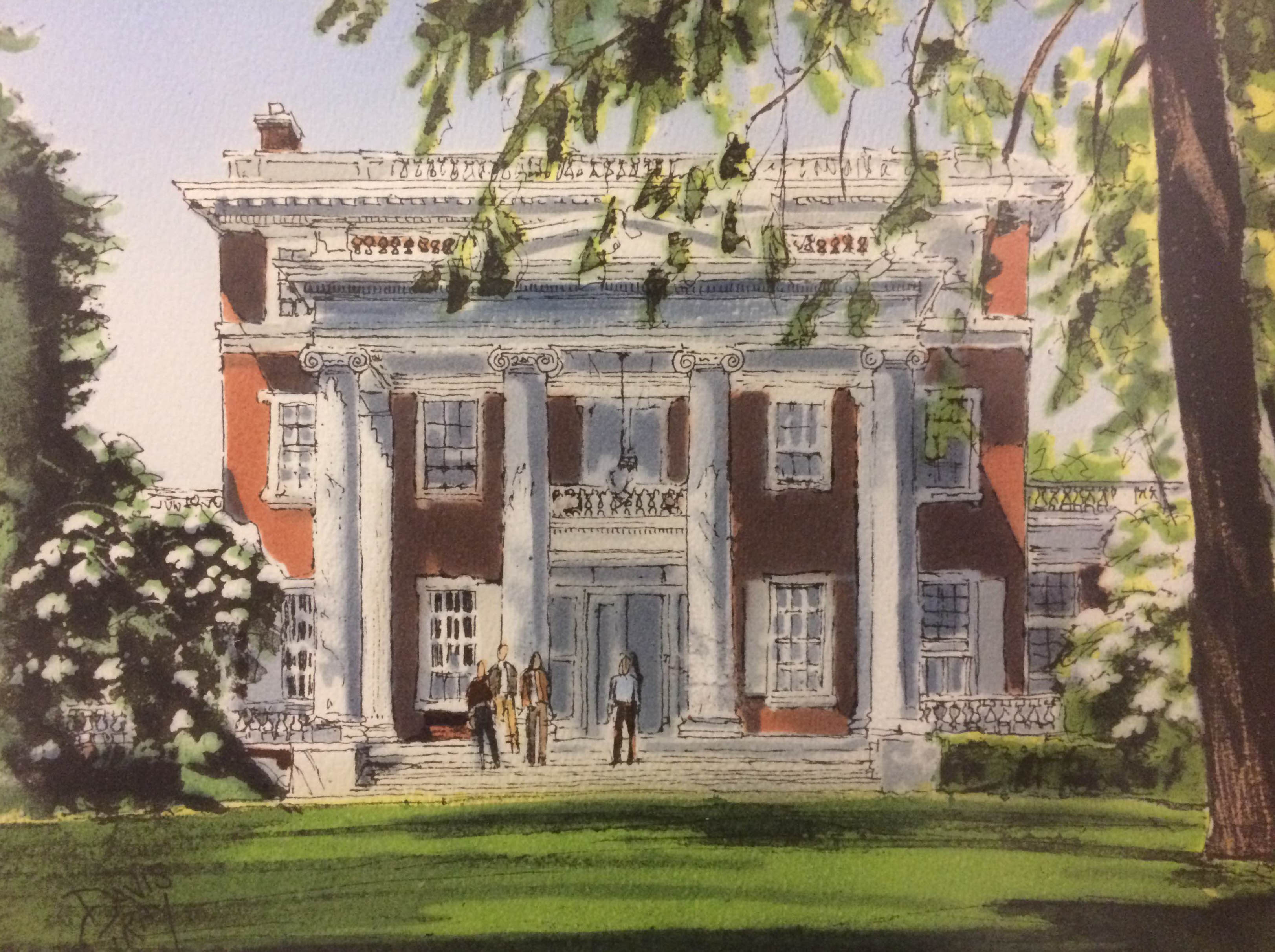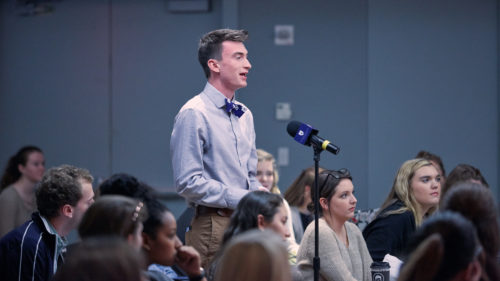October 2016 History Spotlight: Lexington, An American Story
Last month we learned about the very first site of The King’s College—the Marconi estate in Belmar, New Jersey. This month, we turn our attention to the College’s second home in Delaware: a mansion called Lexington, built by an extremely industrious citizen-farmer named Philip Reybold between 1840 and 1845.

Last month we learned about the very first site of The King’s College—the Marconi estate in Belmar, New Jersey. This month, we turn our attention to the College’s second home in Delaware: a mansion called Lexington, built by an extremely industrious citizen-farmer named Philip Reybold between 1840 and 1845.
The entire region of northern Delaware, with most of what is now New Jersey, all of Pennsylvania from the Susquehanna River east, and southeastern New York, was originally home to the Lenape tribe, whose name means simply “people.” Historical fiction writer, reenactor, and local researcher Thomas Tear writes, “Considered to be the oldest tribe on the East Coast, the Lenape’s oral tradition alleged that they had been here since the beginning of time. At least twenty other East Coast tribes called them the ‘grandfathers’ and confirmed that they were descended from the Lenapes.”[1]
When the Delaware River was still known as the Lenapehanna, a bridle path ran along it that supplemented water travel for needs like hunting, farming, and trade. Dutch settlers improved and lengthened it, and it became a profitable main route between Philadelphia and northern Delaware. Along this 400-year-old road, a man named John Newbold purchased land in 1801.[2] He eventually founded Delaware City, but also rented land to Philip Reybold, who eventually built the mansion that would become the home of King’s.
Philip Reybold worked in his father’s sheep dressing business as a child. In 1793 when he was ten, his father died, and he went to work to help support his mother and sister. He wheeled sheep to market in Philadelphia on a handcart or wheelbarrow. Between the ages of ten and nineteen he saw increasing success, and was married in 1801 at nineteen to Elizabeth Dilcart, who would give him twelve children. For another nine years he worked his trade in Philadelphia, then moved to the country to become a farmer. He found a business partner named Worknot, with whom he purchased over 1,000 acres of land in the Red Lion Hundred.[3] Worknot did not make his payments, and the two men were foreclosed upon by the owner. Nothing daunted, Reybold rented the same property from the same owner—sans partner—set to raising merino sheep, and profited enough to rent an additional tract from John Newbold, where he raised castor beans for oil. A local history narrative, commenting on the partnership with the ill-fated Worknot, says, “Having lost all his own early savings and his patrimony, by the disastrous termination of the Worknot partnership, the situation would have been discouraging to a faint heart. But to Major Reybold it afforded chiefly an incentive to greater effort; for his heart was not of the ‘faint’ kind. Robust energy that knew not how to faint or fail and was determined not to learn to do either, was, more than in most men, his predominant characteristic.”[4] His later years bear this out.
Reybold offered his services to the state in 1812 when that war began and was commissioned as a major, but he was never called into the fight. In 1819, he purchased his own land between New Castle and Delaware City, a tract known at that time as Marsh Mount farm. The same narrative recounts,
“He had over four hundred acres under complete cultivation, of which he devoted fifty or sixty acres to beans for oil. The product of these acres was exceedingly profitable. Major Reybold, so far as is known, was the first castor oil producer who used the cold pressure and put the famous cold-expressed castor oil in the market.”[5]
During the 25 years that he lived in his first brick house at Marsh Mount, Reybold served as a construction foreman on part of the Chesapeake Delaware Canal and was contracted to supply bread and meat to the workmen along its entire length, which he successfully did. Later, he turned his attention to brick manufacturing, in which he made millions, using clay deposits on his property. Then in 1835, he planted a small peach orchard. Ten years later, he and his sons were the largest producers in the state. “One day, the Peach Trust in Philadelphia decided to gang up on Reybold and offered him 50 cents a basket for his peaches—half the asking price. Reybold didn’t argue; he simply dumped all the peaches in the river and went home. The trust never argued with him again.”[6]
Reybold built a new mansion on his property between 1840 and 1845. It was Henry Clay, the Congressman, Senator, Secretary of State, and five-time presidential hopeful, who suggested the name Lexington for it while visiting to see his peach orchards—he said it was as beautiful as his hometown in Kentucky.
Reybold died in 1854, aged 71. His son Barney inherited Lexington and it stayed in the family until the 1890s, when it was sold to Henry Pepper Scott, a president of the Wilmington Trust Company. Scott enlarged the mansion to sixty rooms—making it perfect for a young college in need of a new home. Percy Crawford bought it from Scott early in 1941, and the College moved in over the summer.
The students had warmed quickly to the new location. They visited Lexington during a school holiday in the spring and, according to sophomore Jane Atno, were “simply dazzled by what we saw. Nothing could have been more different from the sand dunes and scrub pine of Belmar, than the lovely rolling lawns and the gracious pillars of Lexington.” Percy’s son Dan Crawford recounts of Lexington, “This…‘architectural treasure’ stood on sixty-five acres of beautifully landscaped grounds with formal gardens, a nine-hole golf course, and a working farm.” Lexington provided almost all of the dormitory space, the library, the dining hall, and the recreation hall. Two other buildings were renovated for the chapel, classroom space, science labs, and offices.[7]
Although the students were enthusiastic, it was not an easy time. Only twenty-six of the original class of sixty-seven graduated from King’s; many of their classmates transferred to Wheaton around the time of the move in order to graduate from an accredited institution. The College published a booklet around this time proclaiming that “THE KING’S COLLEGE IS NOW ACCREDITED,” but this was not the case until 1949. In addition, the College’s finances were such that it could not afford to be selective in admissions; “the number of disciplinary cases in some years was alarmingly high.”[8] And in 1942, student enrollment and faculty numbers alike dropped as King’s men answered the call to serve in World War II.
In spite of these lean years, students had high morale and made the most of bright moments. The first graduation in 1942 was a joyful time:
“We prepared for graduation by having our first Campus Day, when the whole student body doffed their studious attitude, cast away their books, donned their oldest clothes, and armed with brush and pail, scrubbed the House [Lexington] and other buildings until they shone. We will long recall the gatherings on the lawn before the great white pillars of the main buildings. Dr. MacRae, President of Faith Theological Seminary, preached the Baccalaureate Sermon, and Dr. Edman, President of Wheaton College, gave the graduation address.”[9]
Dan Crawford notes, “It was important to Percy that Wheaton’s president should be the one to bless the new college and its first graduates, since The King’s College was originally conceived on the Wheaton model.”[10] And the spring formal banquet was the crowning event of the year: “Not even the fact that, at the last minute, one finds that every girl in the school has a dress of the same color as one’s own, can take away from the magic of that night.”[11]
There were not only bright moments, but upward efforts: “In 1946 ten King’s students took over the farm, which was losing money, and formed The King’s Farm Association. They turned the operation into a profitable enterprise, providing the College with its produce, fruit, dairy products, poultry, and meat at wholesale market prices.”[12] And despite the admissions policies (or absence thereof) mentioned above, the College maintained a good academic environment; the most serious students set the tone in their classes, and were matched by a core group of inspiring teachers. Vice President William Jelley’s annual report in 1952 called that year a year of “growing up” and noted that the College only experienced one major disciplinary problem, and student respect for the faculty and administration increased.[13]
Although the College was, perhaps, enjoying this “growing up,” winds were blowing through the region that would soon bring another challenge. The Tidewater Associated Oil Company was buying up the land surrounding King’s with plans to build the second-largest oil refinery and shipping facility in the nation, second only to the Texas Gulf Coast.[14] Tidewater requested that the King’s property be rezoned for industrial development and prevailed with the New Castle County Zoning Commission in spite of vigorous campaigning efforts and appeals to stop it by Percy, his constituents, and others. According to Thomas Tear, King’s was not alone in this protest. The entire River Road area was studded with historic homes, and many civic groups and private parties fought against the rezoning of the entire area.
The state’s motivation to turn a deaf ear appears to have been financial. “In the 1950s and 60s urban renewal devastated the historic corridor along Route 9 in Delaware,” Mr. Tear writes. “We lost over a dozen historically significant homes…The buildings had to be destroyed, and quickly, before preservation groups could get a hold of them and stop industrial expansion.”[15]
Tidewater certainly wasted no time. The campus was sold for $1.25 million and Lexington, along with its outbuildings, was destroyed shortly after commencement in 1955.[16] Mr. Tear says their method of demolition was to burn it to the ground.
The Delaware City Refinery is still in operation today, owned by the Delaware City Refining Corporation, a subsidiary of PBF Energy.[17] But they never built on the site of King’s. The trees that stood in the front of Lexington are still there, and for many years the tennis courts stood open to anyone who wanted to use them. Now the property is fenced off. The refinery has sold off several small parcels of land in the area, so it is not certain, but is likely, that it still owns the old site of King’s.[18]
Many elements of the King’s experience in Delaware may sound familiar to students in later times. Those who went to King’s in the first ten years in Manhattan (including the author) may identify with the financial instability and permissive years in admissions, but also with the deep solidarity, sense of vision, and vivid community of learning described during the years in Delaware. The many alumni who spent time at Briarcliff Manor and have grieved its closing may remark upon the nearly identical fate of the Delaware campus to their own: burnt down and never rebuilt.
What is clear about the Delaware years—and, as we will see, the later events they foreshadow—is that they were fruitful. The College went from scraping by to achieving accreditation and growth. Through both these developments and the proceeds of the Tidewater sale, the Lord was preparing King’s for its next move, to the storied halls of Briarcliff Lodge—of which more next month.
[envira-gallery id=”9347″]
[1] Tear, Thomas. “House of My Father, Part 3” – series in New Castle Weekly, published ____.
[2] Tear. “House of My Father, Part 3,” New Castle Weekly.
[3] Hundreds are the name of a sub-county level geographic division used in Delaware, similar in size to the townships used in New Jersey or Pennsylvania. “Delaware History: ‘Hundreds’,” University of Delaware Library online, accessed October 11, 2016.
[4] “Red Lion Hundred, New Castle County, Delaware,” American History and Genealogy Project, accessed October 11, 2016. Last updated June 1 2015.
[5] “Red Lion Hundred,” AHGP.
[6] Correspondence with Thomas Tear, October 11, 2016
[7] Crawford, Dan. A Thirst for Souls: The Life of Evangelist Percy B. Crawford (1902-1960). Selinsgrove: Susquehanna University Press, 2010. Pp. 195-6.
[8] Crawford, A Thirst for Souls, pp. 196-9.
[9] The Crown, 1943, p. 22. Published by The King’s College.
[10] Crawford, A Thirst for Souls, p. 198.
[11] “Tale-Lights,” The Crown, 1943, p. 21.
[12] Crawford, A Thirst for Souls, footnote 19 on p. 335, citing the 1947 Crown.
[13] Crawford, A Thirst for Souls, footnote 24 on p. 335.
[14] Crawford, A Thirst for Souls, p. 271.
[15] Correspondence with Thomas Tear.
[16] Crawford, A Thirst for Souls, p. 271.
[17] Wikipedia, “Delaware City Refinery,” accessed October 12, 2016 and verified by Thomas Tear.
[19] Correspondence with Thomas Tear.





